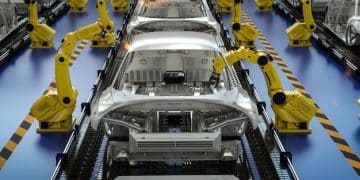Electric Vehicle Battery Shortage: Lithium Supply Gap Predicted by 2027

Industry experts predict a lithium supply gap by 2027, potentially leading to an electric vehicle battery material shortage which may significantly impact electric vehicle prices and production.
Could a looming electric vehicle battery material shortage derail the electric vehicle revolution? Experts are warning of a potential lithium supply gap hitting as early as 2027, leaving manufacturers scrambling and potentially driving up the cost of EVs. Let’s delve into the factors driving this concern and what it might mean for consumers and the industry.
Understanding the Looming Lithium Supply Gap
The demand for electric vehicles is skyrocketing, and so is the need for lithium, a key component in EV batteries. However, are we prepared for this surge in demand? Industry analysts are increasingly concerned about a potential lithium supply gap that could emerge by 2027.
This section will explore the factors contributing to this potential shortage and the implications for the broader electric vehicle market.
The Exponential Growth of EV Demand
The global adoption of electric vehicles is accelerating at an unprecedented rate. Governments worldwide are implementing policies to encourage EV sales, and consumers are becoming more aware of the environmental and economic benefits of electric mobility. This rapid growth is placing immense pressure on the lithium supply chain.
Challenges in Lithium Production
While lithium is abundant on Earth, its extraction and processing are complex and time-consuming. Developing new lithium mines and refining facilities can take years, leading to a potential lag between supply and demand.

- Geopolitical factors: Lithium production is concentrated in a few countries, making the supply chain vulnerable to geopolitical risks and trade disputes.
- Environmental concerns: Traditional lithium extraction methods can have significant environmental impacts, raising concerns about sustainability and responsible sourcing.
- Technological bottlenecks: Existing lithium processing technologies may not be efficient enough to meet the growing demand, necessitating innovations in extraction and refining techniques.
In conclusion, the potential lithium supply gap is a multifaceted issue driven by surging EV demand and challenges in lithium production. Addressing these challenges will be critical to ensuring a sustainable and affordable electric vehicle future.
The Role of Lithium in Electric Vehicle Batteries
Lithium is the cornerstone of modern EV batteries. Its unique properties make it the ideal material for storing and releasing energy efficiently. Without a secure and stable supply of lithium, the entire electric vehicle industry could face serious setbacks.
This section will examine the specific roles lithium plays in EV batteries and why it’s so crucial for their performance.
The lithium-ion battery is the dominant technology in the EV market. It relies on the movement of lithium ions between the anode and cathode to generate electricity. Lithium’s lightweight and high energy density make it superior to other battery chemistries. Alternative battery technologies are being explored, but lithium-ion batteries are expected to remain the standard for the foreseeable future.
However, lithium production methods have environmental and social impacts. Traditional hard rock mining and brine extraction can disrupt ecosystems and displace local communities. Sustainable lithium sourcing and recycling practices are required to minimize the adverse effects of lithium extraction.
The continued feasibility of electric vehicles hinges on a reliable lithium supply. Securing the lithium supply chain through sustainable extraction practices and diversification of sources is essential for the long-term growth of electric vehicles.
Industry Expert Predictions on the Shortage
Analysts and industry experts are closely monitoring the lithium market, and their predictions paint a concerning picture. Many believe that the current lithium production capacity will not be sufficient to meet the projected demand in the coming years.
Here, we’ll dive into expert forecasts and the factors driving their predictions.
- Increased investment: A significant increase in investment in lithium mining and refining projects is needed to bridge the potential supply gap.
- Technological innovation: The development of more efficient lithium extraction and processing technologies can help boost production and reduce environmental impact.
- Diversification of sources: Diversifying lithium supply sources around the world can reduce reliance on specific countries and mitigate geopolitical risks.
Industry analysts such as those at BloombergNEF and Benchmark Mineral Intelligence have issued warnings about the impending lithium shortage. They cite factors such as delays in new lithium projects and the complexities of scaling up production to meet the rapidly growing demand as causes for concern. These predictions highlight the critical need for proactive measures to address the potential supply gap.

Potential Government Intervention
Governments are also taking notice of the potential lithium shortage and considering measures to secure the supply chain. This may include providing funding for research and development of new lithium extraction technologies, incentivizing domestic production, and establishing strategic reserves.
In conclusion, the predictions from industry experts are a call to action. Addressing the potential lithium supply gap requires a collaborative effort from governments, industry, and researchers to ensure a sustainable and affordable electric vehicle future.
Impact on Electric Vehicle Prices
If a lithium supply gap does materialize, one of the most immediate consequences could be a significant increase in electric vehicle prices. Lithium is a major cost component in EV batteries, and any shortage would undoubtedly be passed on to consumers.
This section explores how a lithium shortage could impact EV prices and affordability.
Increased Battery Costs
The cost of lithium-ion batteries typically accounts for a significant percentage of the total price of an electric vehicle. The EV industry is working towards achieving battery price parity with gasoline vehicles, but a lithium shortage could derail these efforts. A disrupted lithium supply would limit production capacity and drive up battery prices, making EVs less competitive in the automotive market.
Price fluctuations have already been observed in the lithium market, reflecting its increased volatility. Geopolitical events, such as trade disputes, can disrupt the lithium supply chain and trigger price spikes. These events can lead to increased costs for EV manufacturers and consumers.
If the lithium supply gap widens, EV manufacturers would be left with difficult choices. They are already increasing production to try to meet demand. Manufacturers will need to consider diversifying battery chemistries, using less lithium-intensive battery designs, and innovating new battery technology.
Alternative Battery Technologies and Material Exploration
The potential lithium shortage is driving research and development into alternative battery technologies and materials. Scientists and engineers are exploring various options to reduce reliance on lithium or replace it altogether.
Here, we will examine potential alternatives and their potential impact on the EV market.
Sodium-Ion Batteries
Sodium is far more abundant and less expensive that lithium. Sodium-ion batteries have been developed in recent years. They offer similar performance characteristics and could become a solid alternative to lithium-ion batteries in particular cases.
Solid-State Batteries
Solid-state batteries use a solid electrolyte instead of a liquid one, potentially offering higher energy density, improved safety, and faster charging times. While solid-state batteries are still in the early stages of development, they hold promise as a lithium alternative.
Another area of exploration is in the battery cell architecture. Researchers are working to optimize the design of lithium-ion batteries, such as cell-to-pack (CTP) and cell-to-chassis (CTC) technologies, that can improve energy density and reduce material usage.
- Lithium-Sulfur Batteries: Replacing the cathode with sulfur means higher energy density and lower cost.
- Graphene Batteries: Graphene-based batteries could offer increased energy density and faster charging speeds.
- Aluminum-Ion Batteries: They offer high energy density, fast charging capabilities, and improved safety.
Strategies for Mitigating the Lithium Shortage
There are several strategies that can be employed to mitigate the potential lithium shortage. These include increasing lithium production, promoting recycling, and investing in alternative battery technologies.
This section examines these strategies and their potential effectiveness.
Increasing Lithium Production
Expanding lithium production capacity is critical to meeting the growing demand. This can be achieved by developing new lithium mines and refining facilities, as well as optimizing existing operations. Streamlining the permitting process for lithium projects and attracting investment in this sector are also important steps.
Promoting Recycling
Recycling lithium-ion batteries can help recover valuable materials, reduce reliance on virgin lithium sources, and minimize environmental impact. Establishing efficient battery collection and recycling infrastructure is essential. Research and development of more efficient recycling technologies can also play a significant role.
In conclusion, mitigating the potential lithium shortage requires a multi-pronged approach that includes increasing production, promoting recycling, and investing in alternative technologies. By taking these steps, we can ensure a sustainable and affordable electric vehicle future.
| Key Point | Brief Description |
|---|---|
| ⚠️ Lithium Shortage | Experts predict a potential lithium shortage by 2027 due to rising EV demand. |
| 💰 Impact on Prices | A shortage could increase EV battery costs, potentially raising vehicle prices. |
| 🔋Alternative Tech | Researching sodium-ion & solid-state batteries decreases reliance on lithium. |
| ♻️Recycling | Increasing battery recycling can recover valuable lithium and reduce the need for new mining. |
Frequently Asked Questions
▼
Industry experts predict that the supply of lithium may not meet the growing demand for electric vehicle batteries starting around 2027, leading to a potential shortage.
▼
A lithium shortage may lead to a rise in the cost of EV batteries, which could increase the overall price of electric vehicles for consumers.
▼
Researchers are exploring battery technologies that rely on sodium-ion, solid-state electrolytes, or graphene for improved energy density and performance.
▼
Increasing lithium production, promoting broader battery recycling, investing in alternative battery technologies can alleviate a lithium shortage.
▼
Lithium is important because it efficiently stores a lot of energy for its size, making it good for electric vehicles. Lithium-ion batteries are now widely used.
Conclusion
The looming potential for a lithium shortage is serious; manufacturers and researchers are already exploring alternative chemistries and more efficient methods for lithium production and recycling. Consumers should stay informed on these challenges and developments to make informed purchasing decisions.





